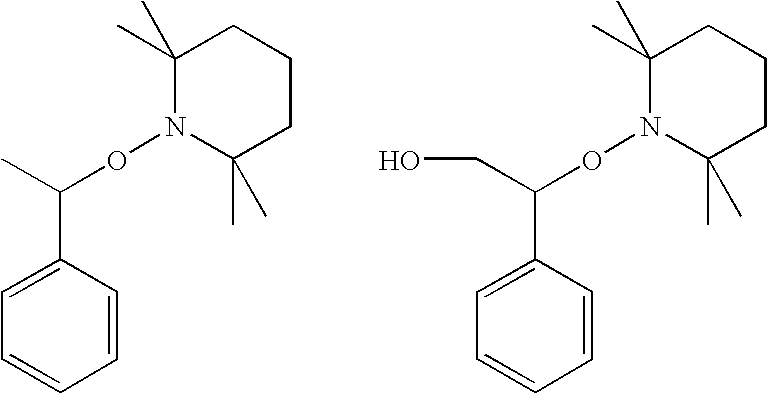Polymer, processes for producing polymer, and composition
- Summary
- Abstract
- Description
- Claims
- Application Information
AI Technical Summary
Problems solved by technology
Method used
Image
Examples
production example 1
Synthesis of Alkenyl-Terminated Poly(butyl Acrylate)
[0268]A 2-liter separable flask equipped with a reflux condenser and a stirrer was charged with CuBr (3.39 g, 0.059 mol) and the reaction vessel inside was purged with nitrogen. Acetonitrile (111.9 mL) was added and the contents were stirred on an oil bath at 70° C. for 40 minutes. Thereto were added butyl acrylate (200 g), diethyl 2,5-dibromoadipate (23.4 g, 0.065 mol) and pentamethyldiethylenetriamine (0.5 mL) (hereinafter referred to as “triamine”) to thereby initiate the reaction. While heating at 70° C. with stirring, butyl acrylate (800 g) was continuously added dropwise. During adding dropwise butyl acrylate, the triamine (2.5 mL) was added. After the lapse of 380 minutes following reaction initiation, 1,7-octadiene (288 mL, 215 g, 1.95 mol) and the triamine (4.0 mL) were added and the resulting mixture was further heated at 70° C. with stirring for 8 hours.
[0269]The reaction mixture was diluted with toluene and passed throu...
example 1
Synthesis of Silanol-Terminated Poly(butyl Acrylate)
[0272]A 30-mL pressure reactor was charged with the polymer [3] (10 g) synthesized in Production Example 1 and then purged with nitrogen. Chlorodimethylsilane (0.34 mL, 3.1 mmol), zero valence platinum-1,1,3,3-tetramethyl-1,3-divinyldisiloxane complex (1.32×10−6 mol / ml; xylene solution) (0.079 mL) and toluene (2.0 mL) were added and the contents were heated at 100° C. with stirring. Three hours later, 0.071 mL of zero valence platinum-1,1,3,3-tetramethyl-1,3-divinyldisiloxane complex (1.32×10−6 mol / ml; xylene solution) was added and heating was continued at 100° C. with stirring for further 6 hours. The volatile matter of the reaction mixture was distilled off by heating at 80° C. under reduced pressure to give chloro-dimethyl-terminated poly(butyl acrylate) (polymer [5]).
[0273]The polymer [5] was dissolved in tetrahydrofuran (10 mL) and the solution was heated at 50° C. with stirring. A 10% aqueous solution of NaHCO3 (10 mL) was a...
example 2
Production of Cured Product
[0274]A composition was prepared by mixing up 100 parts of the polymer [6] obtained in Example 1, 3 parts of methyltriisopropenoxysilane and 1 part of a tin catalyst. The composition was cast into a form and allowed to cure at room temperature, whereby a cured product having rubber-like elasticity was obtained.
PUM
| Property | Measurement | Unit |
|---|---|---|
| Composition | aaaaa | aaaaa |
| Hydrolysable | aaaaa | aaaaa |
Abstract
Description
Claims
Application Information
 Login to View More
Login to View More - Generate Ideas
- Intellectual Property
- Life Sciences
- Materials
- Tech Scout
- Unparalleled Data Quality
- Higher Quality Content
- 60% Fewer Hallucinations
Browse by: Latest US Patents, China's latest patents, Technical Efficacy Thesaurus, Application Domain, Technology Topic, Popular Technical Reports.
© 2025 PatSnap. All rights reserved.Legal|Privacy policy|Modern Slavery Act Transparency Statement|Sitemap|About US| Contact US: help@patsnap.com



